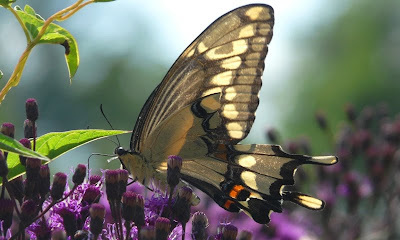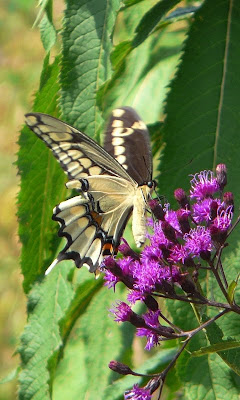Butterflies from Randolph County
Thursday I visited a stream mitigation site in Randolph County, Indiana, that used to be pasture. Large parts of the former pasture are now covered with blooming Ironweed. The butterflies were going crazy.
 Adult female yellow form Tiger Swallowtail (Pterourus glaucus glaucus)
Adult female yellow form Tiger Swallowtail (Pterourus glaucus glaucus)I was taken by the amount of blue in the hind wing. The males are yellow and black, but have very little blue or none at all (Jeffery Belth, pers com).
 A female dark form Tiger Swallowtail (Pterourus glaucus glaucus). Female Tiger Swallowtails can be either black or yellow. According to Butterflies of Indiana by Shull, most females in the state are black. The dark form female is more common in southern Indiana than the yellow form, but in northern Indiana, where the mimicry model (the Pipevine Swallowtail) is less common, the frequency of the two forms probably begin to even out (Jeffery Belth, pers com).
A female dark form Tiger Swallowtail (Pterourus glaucus glaucus). Female Tiger Swallowtails can be either black or yellow. According to Butterflies of Indiana by Shull, most females in the state are black. The dark form female is more common in southern Indiana than the yellow form, but in northern Indiana, where the mimicry model (the Pipevine Swallowtail) is less common, the frequency of the two forms probably begin to even out (Jeffery Belth, pers com).  The Giant Swallowtails (Heraclides cresphotes or Papilio cresphontes) were very showing in the field of Ironweed. The pictures don't convey the size of these butterflies. The Butterflies of Indiana gives their wingspread as 3.4 to 5.5 inches, but they look like monster butterflies.
The Giant Swallowtails (Heraclides cresphotes or Papilio cresphontes) were very showing in the field of Ironweed. The pictures don't convey the size of these butterflies. The Butterflies of Indiana gives their wingspread as 3.4 to 5.5 inches, but they look like monster butterflies. I love their black and yellow upper wing surface, but they never cooperated. They never stopped their wings from fluttering while they were feeding.
I love their black and yellow upper wing surface, but they never cooperated. They never stopped their wings from fluttering while they were feeding. Milbert's Tortoiseshell, (Aglais milberti milberti)
Milbert's Tortoiseshell, (Aglais milberti milberti)After seeing thousands of butterflies in the Ironweed field, this guy landed on the bare soil of the corn field as we were walking out. I knew I had never seen a butterfly like this before. (Quite a thrill.)
 Here is some population information about the Milbert's from Jeff Belth -
Here is some population information about the Milbert's from Jeff Belth -"There are probably a few permanent populations of Milberts in Indiana, but individuals seem to occur in low densities. In some years these populations are bolstered by individuals that wander in from the North, and it sometimes appears that the species has become a well established and common permanent resident, but then the populations disappear after a few years and individuals become uncommon again."



No comments:
Post a Comment